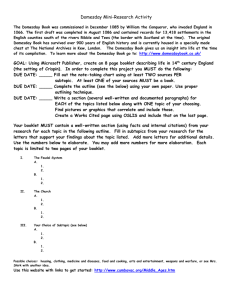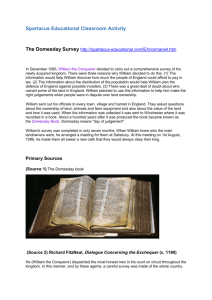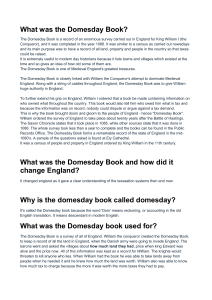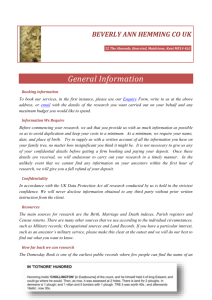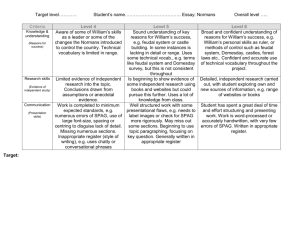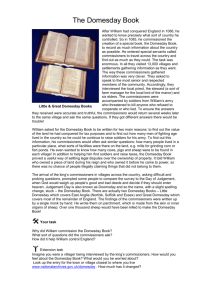Focus on Domesday Learning Curve Key Stage 3
advertisement
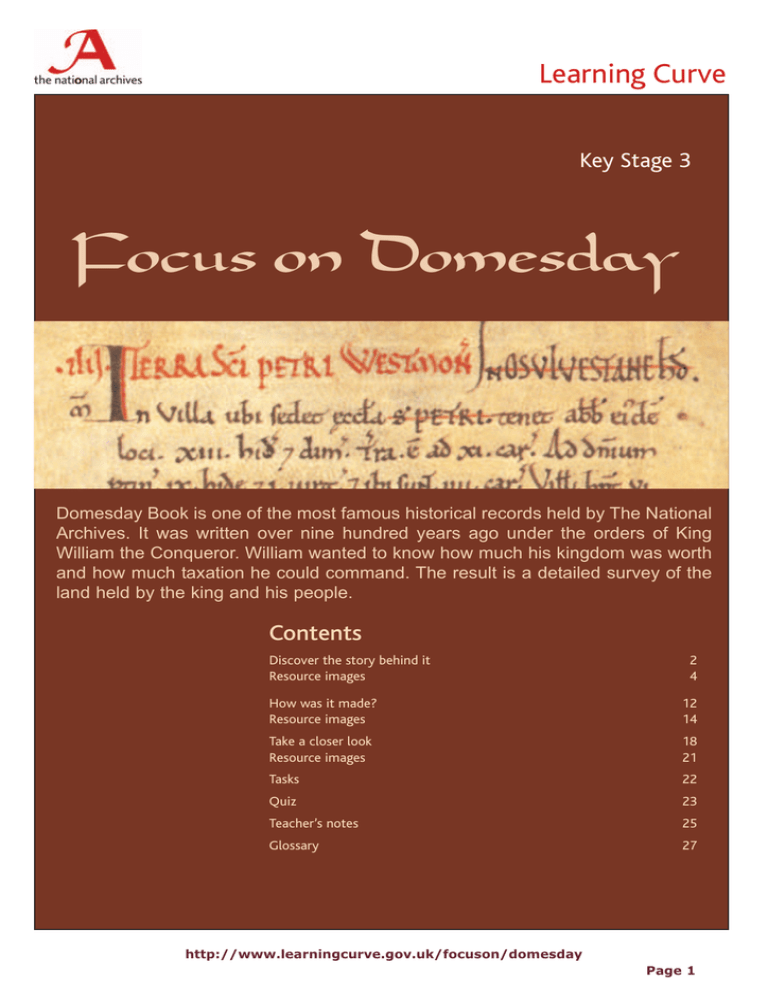
Learning Curve Key Stage 3 Focus on Domesday Domesday Book is one of the most famous historical records held by The National Archives. It was written over nine hundred years ago under the orders of King William the Conqueror. William wanted to know how much his kingdom was worth and how much taxation he could command. The result is a detailed survey of the land held by the king and his people. Contents Discover the story behind it Resource images 2 4 How was it made? Resource images 12 14 Take a closer look Resource images 18 21 Tasks 22 Quiz 23 Teacher’s notes 25 Glossary 27 http://www.learningcurve.gov.uk/focuson/domesday Page 1 Learning Curve Discover the story behind it Discover the story behind it The death of Edward the Confessor Edward the Confessor, the King of England, died on 5th January 1066. Before his death, it was decided that Harold Godwinson, the Earl of Wessex should be the next king. He had no royal blood but he was the most important noble in the land. On the very same day that Edward the Confessor was buried, in the same cathedral, Harold was crowned King of England. King Harold knew that keeping the throne was not going to be easy. Two other men claimed that it belonged to them. One was William of Normandy who said that Edward had named him as his successor. The other was Harold Hardrada, the Viking King of Norway. He claimed the throne through his connections with King Cnut and his son, rulers before Edward. In December 2005, archeologists using radar under Westminster Abbey discovered the original ancient burial tomb of Edward the Confessor. 1066: a year of battles Shortly after Harold became king, Harold Hardrada invaded the north of England. King Harold defeated Hardrada at the battle of Stamford Bridge. News then reached King Harold that his other rival for the throne, William of Normandy, had landed at Pevensey on the south coast of England. King Harold and his army had to quickly march south. His soldiers were tired and with no trains or planes to make it easier, some dropped out, too exhausted to continue. To replace them, King Harold recruited about 7,000 ordinary peasants along the way. He still had his Saxon housecarls, a strong core of fierce soldiers. On 14 October 1066, the English and Norman armies clashed in a battle just outside Hastings. The English had more men, but the Normans had mounted knights (cavalry) and archers. For a while things were going in the favour of the English. They had positioned themselves in a strong defensive position on high ground but lost this advantage when they chased after the Normans who they thought were fleeing in fright. Instead, William regrouped his army and surrounded Harold's men, cutting them to shreds. Thousands of the English were slaughtered, including King Harold. Legend has it that he was shot in the eye by an arrow, but many historians now believe that Harold was hacked to death. William, Duke of Normandy was the victor. To prove it, he was crowned King of England on Christmas Day 1066. From king to conqueror After the Battle of Hastings William was king in name only. He did not have full command of the country. He only controlled a tiny corner of England. What is more, most of the English did not want him as their king. Numerous rebellions broke out. William showed no mercy in putting a stop to each one. In Yorkshire he was especially harsh. Homes were burnt to the ground, animals and crops destroyed and hundreds of people were killed. Hundreds more were left to die from starvation. http://www.learningcurve.gov.uk/focuson/domesday Page 2 Learning Curve Discover the story behind it William did not trust the English. He took all the land and important jobs in the Government and Church away from them and divided it up amongst his Norman friends. He built castles for his Norman soldiers to use as bases. Most of all, castles made the English feel so scared that they did not think about causing trouble. Wealth of a nation Invading and conquering England had been expensive. However, a shortage of money was not William's only problem. By 1085 many Normans had begun to disagree amongst themselves over the land they had been given as a reward for helping conquer England. William wanted to settle these disputes once and for all. In December 1085, William met his Great Council (a team of advisors) in Gloucester to discuss how to solve these problems. At the meeting William decided to order a survey. It would list all the landowners and their tenants and the lands they held. It would describe any other people who lived on the land from villagers to slaves. It would describe how the land was used, if it was used for woodland, meadow or animals. All buildings such as castles, churches or mills were to be recorded. The survey would show William the wealth of his kingdom. Importantly for him, William could find out how much money he could raise in taxes from his people. This survey resulted in Domesday Book. http://www.learningcurve.gov.uk/focuson/domesday Page 3 Learning Curve Discover the story behind it > Resource images A page from Little Domesday An extract from Little Domesday, Essex (Catalogue ref: E31/1/1) Simplified translation for extract http://www.learningcurve.gov.uk/focuson/domesday Page 4 Learning Curve Discover the story behind it > Resource images The death and funeral of Edward the Confessor The death and funeral of Edward the Confessor. Detail of the Bayeux Tapestry, 11th century. By special permission of the City of Bayeux. http://www.learningcurve.gov.uk/focuson/domesday Page 5 Learning Curve Discover the story behind it > Resource images Abbreviatio of Domesday Image from the Abbreviatio (abridgement) of Domesday Book c.1241. The early part of this document shows scenes from the life and miracles of Edward the Confessor (Catalogue ref: E 36/284) http://www.learningcurve.gov.uk/focuson/domesday Page 6 Learning Curve Discover the story behind it > Resource images Edward the Confessor’s Shrine Edward the Confessor's shrine in Westminster Abbey, © Dean and Chapter of Westminster http://www.learningcurve.gov.uk/focuson/domesday Page 7 Learning Curve Discover the story behind it > Resource images The death of Harold The death of Harold. Detail of the Bayeux Tapestry, 11th century. By special permission of the City of Bayeux. http://www.learningcurve.gov.uk/focuson/domesday Page 8 Learning Curve Discover the story behind it > Resource images Important locations in 1066 Important locations in 1066 http://www.learningcurve.gov.uk/focuson/domesday Page 9 Learning Curve Discover the story behind it > Resource images Rochester Castle Rochester Castle ©1995 Rod Hampton http://www.learningcurve.gov.uk/focuson/domesday Page 10 Learning Curve Discover the story behind it > Resource images A Domesday manor A picture to show a Domesday manor. “The Children’s Book of Domesday England © Kingfisher Publications Plc. Reproduced by permission of the publisher, all rights reserved”. http://www.learningcurve.gov.uk/focuson/domesday Page 11 Learning Curve How was it made? How was it made? A difficult job Translation "[King William] sent his men over all England into every shire and had them find out how many 100 hides there were in the shire, or what land and cattle the King himself had in the country or what dues he ought to have in the 12 months from the shire. He also recorded how much land his archbishops had and his bishops and his abbots and his earls how much each man who was a landholder in England had in land or livestock and how much money it was worth". To collect so much information and in such minute detail could not have been an easy job. The work was made harder because very few people in England at this time could read or write. The people in England spoke Saxon-English. The lords and the men who were sent out to collect the information spoke Norman-French or Latin. Someone reliable had to be found who could understand and translate what the English were saying. What is more, the English people were not exactly pleased about this survey in the first place. Nobody had asked them such searching questions before. They did not want to pay more taxes either. Not surprisingly, the temptation to tell lies was very strong. The men who collected the information had to check that it was accurate. Collecting the information The process of collecting the information to make Domesday Book was done in stages. Stage 1 All Norman lords who had been given land by King William were asked to gather details about their lands. This information was sent to King William's advisors. Stage 2 King William then sent groups of officials to most parts of England to check the details that the Norman lords had sent in. They were also told to get even more information. Stage 3 When they had finished questioning a village, the officials sent their findings to King William's advisors. The findings may have been given to King William in August 1086. Stage 4 All findings were written up into the two volumes of Domesday Book. Great Domesday was written by one scribe and checked by a second. They were told exactly what important details to include. They had to try and make sure that the same type of information was recorded for each place. Little Domesday was probably written first and it is the work of at least six scribes. http://www.learningcurve.gov.uk/focuson/domesday Page 12 Learning Curve How was it made? Writing it up Writing was hard work. Before writing, the scribe ruled out each line. Every letter of each word had to be perfectly shaped, to make it easy to read. The scribe who wrote Great Domesday was very careful, but with so much to do, he made quite a few mistakes! However, wherever you see a word crossed out in red, the scribe was highlighting the word. These are not errors! This method of highlighting words is called rubrication. Sheep-skin parchment Great Domesday was made from nine hundred sheepskins. These were soaked in a lime solution and scraped to remove the animal hairs. The skins were then stretched over wooden frames and left to dry out to make parchment. Writing tools The scribe wrote with a quill usually made from a goose feather. These quills had a tip that was broad and slanted like the blade of chisel. Ink In the Middle Ages, ink was made from the juices of plants, leaves and roots. The ink used in Domesday Book was made from oak galls. These are little brown growths on oak trees caused by insects or fungus. The ink would have dried to a black colour, but over the years it has turned brown. The scribe also used red ink. This was made from red lead. The red ink was used for headings or to underline names or important pieces of information. Which places are included? More than 13,000 places are recorded in Domesday Book. Most of them still survive today. Domesday Book describes almost all of England. However, County Durham and Northumberland do not appear because King William did not fully control these areas. A few places, which are now in North Wales, are in Great Domesday. Great Domesday also covers the rest of England, except for Essex, Norfolk and Suffolk. These counties are included in Little Domesday. Some very important towns were surveyed, but the results were never entered into the spaces left for them in Great Domesday. One missing place was Winchester, the capital city of England in 1086. Another missing place was London, which was already the richest and largest city in the land. http://www.learningcurve.gov.uk/focuson/domesday Page 13 Learning Curve How was it made? > Resource images Great Domesday Photograph of Great Domesday, Somerset. (Catalogue ref: E31/2/1) http://www.learningcurve.gov.uk/focuson/domesday Page 14 Learning Curve How was it made? > Resource images Extract from the Anglo Saxon Chronicle An extract from the Anglo Saxon Chronicle © The Bodleian Library, University of Oxford, MS Laud Misc. 636, fol. 62v. http://www.learningcurve.gov.uk/focuson/domesday Page 15 Learning Curve How was it made? > Resource images Making a goose feather quill Making a goose feather quill http://www.learningcurve.gov.uk/focuson/domesday Page 16 Learning Curve How was it made? > Resource images Domesday circuit map Map to show the counties that were visited http://www.learningcurve.gov.uk/focuson/domesday Page 17 Learning Curve Take a closer look Take a closer look Close up Look closely at this extract from Domesday Book, and see if any words look familiar, then read the translation below. An extract from Domesday Book, Westminster. (Catalogue ref: E31/2/1) IIII. The Land of St. Peter of Westminster In 'Ossulstone' Hundred. In the vill in which St. Peter's Church is situated [Westminster] the abbot of the same place holds 13½ hides. There is land for 11 ploughs. To the demesne belongs 9 hides and 1 virgate, and there are 4 ploughs. The villeins have 6 ploughs, and there could be 1 plough more. There are 9 villeins each on 1 virgate and 1 villein on 1 hide, and 9 villeins on each half a virgate and 1 cottar on 5 acres, and 41 cottars who pay 40 shillings a year for their gardens. [There is] meadow for 11 ploughs, pasture for the livestock of the vill, woodland for 100 pigs, and 25 houses of the abbot's knights and other men who pay 8 shillings a year. In all it is worth £10; when received, the same; TRE £12. This manor belonged and belongs to the demesne of St. Peter's Church, Westminster. Translation from the Latin version in Domesday Book, the words in square brackets have been left out of the Latin http://www.learningcurve.gov.uk/focuson/domesday Page 18 Learning Curve Take a closer look Why Latin? England's rulers spoke French, rather than English, at the time when Domesday Book was written. Latin was the language used for government documents. It was also the language of the Church. All church services were in Latin and bibles were also written in Latin. Since the scribe for Domesday Book was a churchman and it was made for the King's government, it was written in Latin. Latin was still used for important documents right up to Victorian times. The scribe who wrote Domesday Book also shortened some of the Latin words. Books were often written in this way, as it saved space. However this fact makes Domesday Book hard to read. All numbers are written as Roman numerals. An extract from Domesday Book, Westminster. (Catalogue ref: E31/2/1) http://www.learningcurve.gov.uk/focuson/domesday Page 19 Learning Curve Take a closer look What can we find out? For someone looking back at the Middle Ages, Domesday Book is a very important source of information. Domesday Book gives us a 'snapshot' of what life was like in the Middle Ages. For family historians also, it provides a useful and fascinating resource for tracing family history! By studying a few extracts we can quickly see that England was a very different place from today. How people lived Very few towns are mentioned in Domesday Book. Places such as Birmingham, which are cities today with plenty of businesses and wealth, were tiny manors. There were lots of meadows, pastures and woodland. There were plenty of sheep, pigs and cattle. Not all of the land was used for farming though. Some of it was woodland, forest or wasteland. Domesday Book gives us an idea about the different types of people who lived in England. We can discover how society was organised. Most of the people were villeins, bordars or slaves and they earned their living by farming. Others lived in towns that were small by today's standards. These people worked at different trades or had market stalls. Normans in control By studying Domesday Book, we can find out who controlled the land in England. In 1086 only a handful of English people held land. King William, his tenants-in-chief or the church had power over most of it. This shows us how thoroughly the Normans had taken over England by 1086. A wealthy country The main aim of Domesday Book was to find out how wealthy England was. The total value of the land recorded in the survey was about £73,000. This might not seem a lot today, but in the Middle Ages someone who earned £10 a year was considered to be very well off. What Domesday Book does not show us Domesday Book does not show us how many people lived in England. Only the heads of household are listed. No children, monks, nuns or people who lived in castles are recorded. Major cities such as Winchester and London are left out. Finally, it does not tell us what ordinary people thought, what their homes were like, or what clothes they wore. We have to use other sources along with Domesday Book to get more idea about life in the Middle Ages. http://www.learningcurve.gov.uk/focuson/domesday Page 20 Learning Curve Take a closer look William and his half brothers Bishop Odo and Robert William and his half brothers Bishop Odo and Robert. Detail of the Bayeux Tapestry, 11th century. By special permission of the City of Bayeux. http://www.learningcurve.gov.uk/focuson/domesday Page 21 Learning Curve Activities > Tasks Tasks Old place names Domesday Book gives the names of many places that are still around today. Are there any Saxon or Norman place names in your area? One Battle - two Stories It is 1090. You are an old Norman soldier who fought at the Battle of Hastings. Your grandchildren want to know what happened. Tell them what happened from your point of view. How would your version of events be different from that of a Saxon soldier? Can Domesday Book be trusted? Make a list of all the reasons why Domesday Book might not give a very accurate picture of life in medieval times. Think about the details that are missing. The Day of Judgement! 'Domesday' means 'Day of Judgement'. There is a passage in the Bible that talks about what will happen on the 'Day of Judgement'. Try to find this passage. It is near the very end of the Bible (Revelation chapter 20, verses 11-13). Read it. Why do you think Domesday Book was named after the 'Day of Judgement'? A Domesday Book for today? Write a modern Domesday Book entry. Write your own entry for your local area or a town or village of your choice. List the questions you would need to ask. Think about the best way to collect the information. How would you present your findings? What things could people in the future find out from your entry? What have the Normans done for us? The Normans made their mark on England in many ways. They gave the English language many French words. They left behind buildings built in a Norman style. Visit a church or cathedral that was built in the early part of Middle Ages. Find out about the history of the church and whether there are any Norman parts still surviving. Round arches and doorways tend to give you clues about a building's Norman roots. Visit a castle Why not visit a castle? Check that is was a proper castle though, and not one just built to look like it. You could try the Tower of London, Totnes Castle in Devon, Chepstow Castle, Clifford's Tower in York, Bunratty Castle in Northern Ireland, or White Castle in Gwent. Find out how the castle was defended. If you were on the outside, how would you attack it? Remember, do not include methods from other times. Find out what life inside the castle would have been like for a knight, a lord, a lady and a servant. http://www.learningcurve.gov.uk/focuson/domesday Page 22 Learning Curve Activities > Quiz Activities Quiz 1. When did King William order the Domesday survey to begin? 6. TRE is Latin shorthand which means January 1066 In the time of King Edward December 1085 Tax Royal Earls October 1086 Edward is no longer King 2. What was a villein? Someone who broke the law A higher class of peasant who rented some land 7. What two colours of ink were used in Domesday Book? Blue and Black Brown and Black Red and Black A slave 3. What language was used to write Domesday Book? 8. What is used to make the pages of Domesday Book? Norman-French Parchment (sheep-skin) Anglo-Saxon Vellum (calf-skin) Latin Paper 4. How many scribes wrote Great Domesday? 9. The total value of the lands recorded in Domesday Book was Twelve £37,000 One main scribe with another checking £73,000 Four scribes who took turns £1,000,000 5. Which people are not mentioned in Domesday Book? 10. In the Middle Ages people wrote with William I, the Conqueror Fountain pens Abbots Quills Richard the Lionheart Pencils http://www.learningcurve.gov.uk/focuson/domesday Page 23 Learning Curve Activities > Quiz 11. King William controlled England in all of the following ways, except by 13. Where is Domesday Book kept today? being kind The British Museum building castles The National Archives crushing rebellions Durham Cathedral 12. Who became King of England after the death of Edward the Confessor? 14. Domesday Book … Harold Hardrada, King of Norway lists the names of all the people who lived in England in the Middle Ages William Duke of Normandy tells the story of the Battle of Hastings Harold Godwinson is arranged county by county http://www.learningcurve.gov.uk/focuson/domesday Page 24 Learning Curve Teacher’s notes Teacher’s notes Key stage 3 Focus On Domesday can be used with key stage 3 pupils in year 7. It can form part of a study of the impact of the Norman Conquest and on the structure of medieval society. Objectives • To place Domesday Book in the context of the Norman Conquest. • To try and assess the value of Domesday Book as a historical source for the 11th cen tury. National Curriculum History Study Unit (8) Britain 1066 - 1500. A study of major features of Britain's medieval past: the development of the monarchy, and significant events and characteristic features of the lives of people living throughout the British Isles, including the local area if appropriate. QCA schemes of work How hard was life for medieval people in town and country? http://www.standards.dfes.gov.uk/schemes2/secondary_history/his02/?version=1 How did medieval monarchs keep control? http://www.standards.dfes.gov.uk/schemes2/secondary_history/his02/?version=1 Focus on Domesday explores the following areas: Discover the story behind it Death of Edward the Confessor 1066: a year of battles From king to conqueror Wealth of a nation How it was made? A difficult job Collecting the information (includes film clips with actors in reconstruction) Writing it up Which places are included? Take a closer look Close up Why Latin? What we can find out Activities Tasks Quiz http://www.learningcurve.gov.uk/focuson/domesday Page 25 Learning Curve Teacher’s notes Focus on Domesday contains a glossary and there is a printable pdf available that contains all images and the text. A translation for the document on the home page is also included. Suggestions on how to introduce Domesday Book as a topic: • Discuss how different styles of handwriting have developed; the lack of a printing press until the 15th century; how rare books were at this time; the existence of ancient languages; and the pains and pleasures of using original handwritten documents! • Show the pupils a page from Domesday Book, available online. Ask them to note down their observations, for example, its age, the language used, letter shapes, and so on. • Ask the pupils to identify individual letters and then words that seem to be familiar. • Give students some background information on the creation of Domesday Book. Ask them to speculate about the information it contains, how that information was collected, who wrote it and what problems may have been encountered. Extension Activities • Pupils role-play a visit from William's men to carry out a survey of a village. Use the "How it was made" section and the film clips to help get started. • Write a newspaper obituary for William the Conqueror. • Visit Domesday Book at The National Archives. • Attend Domesday Workshop: Year 7 Special Event: Domesday Book - Day of Judgement offered by the Education Service at The National Archives. http://www.nationalarchives.gov.uk/educationservice/ks3.htm - 2 Links http://www.learningcurve.gov.uk/snapshots/snapshot44/snapshot44.htm http://www.nationalarchives.gov.uk/documentsonline/ http://www.learningcurve.gov.uk/focuson/domesday Page 26 Learning Curve Glossary Glossary Abbot the monk who was in charge of other monks in a monastery. Acre a unit of land (4,840 square yards). Arpent French term for measuring the size of a vineyard. Bordar/Cottar an unfree peasant, who had very little or no land. They probably lived in a cottage out side the main manor. Most people in England during the Middle Ages were bordars or cottars. County/Shire a large area of England. In 1086, England was divided up into many counties. Some examples of counties are Essex, Kent, Yorkshire, Gloucester, Norfolk and Wiltshire. Demesne this means land which only the earl or lord of the manor used. People in the manor would have to work on this land for him. Dues taxes or money that everyone had to pay to King William. Earl a lord or powerful landowner, in charge of several counties. Hide a piece of land large enough for one family to live on. It could be between 40 and 120 acres. Hundred part of a county. A piece of land that was 100 hides in size. This was called a wapentake in the northern counties. Knights soldiers. Livestock animals - sheep, cattle, pigs. Manor/Estate a farm belonging to one earl or lord. It was made up of land which the earl or lord owned and land which peasants rented from him. Meadow land used for grazing animals and for growing hay. Muid French term for a measure of liquid Normans people who came from Normandy in France. They came to England and settled after the Battle of Hastings in 1066. King William was Duke of Normandy as well as King of England. Plough this means a team of oxen and a plough. Rebellion a fight against your rulers. http://www.learningcurve.gov.uk/focuson/domesday Page 27 Learning Curve Glossary Saxons the English-speaking people who lived in England before the Normans invaded. Scribe someone whose job is to write things by hand. In the Middle Ages very few people could write. Those who could were often monks who made copies of the bible or wrote important letters for kings, archbishops and earls. There were no printing machines, so any writing had to always be done by hand. Shilling twelve old pence (five pence in today's money). TRE shortened Latin meaning 'In the time of King Edward'. Vill a small village. Victor someone who has won a battle. Virgate a quarter of a hide. Villeins a higher class of unfree peasant. Villeins owned land, but they also had to work on the earl's land or demesne. Woodland small patches of land for grazing pigs or used for firewood. Anyone could use the woodland. http://www.learningcurve.gov.uk/focuson/domesday Page 28
